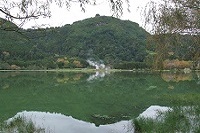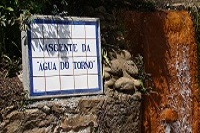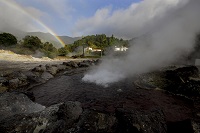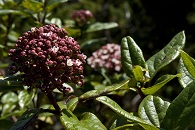


The classification of the protected landscape area of Furnas was based on the singularity of the geomorphological and hydrological features of the Furnas Caldera, notably the lake and manifestations of secondary volcanism, such as fumarolic fields and thermal water spring. The landscape is still marked by manicured garden parks associated with important socio-cultural and patrimonial traits. The lake, as well as the center of the Furnas community is included in a protected area of 7,784 acres.
Geologically, the Furnas Volcano is one of three active volcanoes on the island of São Miguel and bears great geological significance in the Azores. It corresponds to a stratovolcano with a caldera collapse, stratigraphically characterized by the alternation of lava flows and predominantly trachytic and pyroclastic materials, such as ash and pumice.
Currently, the dominant plant communities include a large number of exotic species, some with invading character: the Australian Cheesewood (Pittosporum undulatum) and Australian Blackwood (Acacia melanoxylon) are two examples, in addition to the Yellow Ginger-Lilly (Hedychium gardnerianum) and Chilean Rhubarb (Gunnera tinctoria).
The Furnas Lake recuperation project has reintroduced thousands of endemic and native plants of various species that were extinct or scarcely encountered in the landscape of the Furnas Lake watershed, such as Picconia azorica, Azorean Juniper (Juniperus brevifolia), Portugal Laurel (Prunus azorica) and Buckthorn (Frangula azorica).
The margins of the Furnas Lake host a vast variety of bryophytes, specially of the Hepaticae (leafy liverworts) species, including Scalewort (Radula nudicaulis), Pouncewort (Aphanolejeunea sintenisii), Irish threadworts (Telaranea europaea) and the Bird's-Claw Moss (Alophosia azorica), among others. These species are particularly abundant along the waterfall, on the banks of Ribeiro do Rosal. Currently, the waterfall and the diversity of lichens and bryophytes present can be seen by following a small unofficial trail easily accessible.



Furnas Lake is an excellent place for bird enthusiasts to spot species such as the Grey Heron (Ardea cinerea); a migratory species that can be sighted throughout the year. Other species, such as ducks and waders also take advantage of the banks along the lake, to rest during their long migratory journey. The forested area around the lake is a desirable location for birds as it is an excellent food source, as well as a place to provide shelter, thus allowing the observation of several endemic subspecies of the region: the Common Chaffinch (Fringilla coelebs moreletti); Blackbird (Turdus merula azorensis); Goldcrest (Regulus regulus azoricus); Common Wood Pigeon (Columba palumbus azorica) and Common Buzzard (Buteo buteo rothschildi). The lake also serves as refuge for some marine bird species, such as the Common Tern (Sterna hirundo), the Roseate Tern (Sterna dougallii) and the Yellow-legged Gull (Larus michahellis atlantis).
The area surrounding the Furnas Lake is also distinguished by the abundance and diversity of invertebrate species, such as molluscs, and insects. There are approximately 50 species of molluscs, of which 19 are endemic, while 12 endemic species of insects have been recorded. The Azorean Bat (Nyctalus azoreum) is the only endemic mammal of the archipelago and can also be observed around the lake.
The following species of aquatic fauna exist in Furnas Lake: Roach (Rutillus rutillus), Common Carp (Cyprinus carpio), Northern Pike (Esox lucius), Perch (Perca fluviatilis) and Pike Perch (Sander lucioperca). The first two species do not require a license for fishing, however, the last three do require a fishing license for fresh waters, to be issued by the Regional Management of Forest Resources.
The Furnas Volcanic Complex is classified as a Ramsar site since 2008, under the Convention on Wetlands. Besides being an important transit point for migratory birds, it also holds the classification of geothermal wetlands.
The Furnas Lake is still classified as a mass of protected water through the Furnas Lake Land Development and Watershed Plan (POBHLF), which aims to control eutrophication, aligning the uses and human activities with the protection and environmental enhancement of the watershed and thereby improve water quality. To implement the POBHLF wide expanses of pasture and some forest were acquired. In these areas, the sources of contamination of the lake (fertilizer and manure) were eliminated and currently follow a vigorous ecological restoration plan which will lead to a multifunctional forest landscape; thereby tourism focusing on nature will continue to flourish and has become a cornerstone for the tourism industry in São Miguel.
Located on the banks of Lagoa das Furnas, the Furnas Monitoring and Research Center (CMIF), was created to promote actions for ecological restoration of the lake.
There are two approved hiking trails in the Protected Landscape Area of Furnas: PRC6 SMI Furnas and SMI PR22 Pico do Ferro – Calderas of Lagoa das Furnas. Each trail covers areas of exceptional beauty, while linking almost every corner, lake, village, coast and mountain… an entertaining excursion to say the least.
For more information about this protected area | Click here
< Previous page